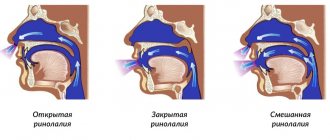Article:
For speech impairments associated with auditory-verbal memory disorders, doctors make a diagnosis of “Acoustic-mnestic aphasia.” The pathology is characterized by difficulty repeating combinations of words, as well as difficulties in selecting specific words. To make a diagnosis, speech therapy examination, magnetic resonance imaging and other methods of laboratory and instrumental diagnostics are used. Correction of acoustic-mnestic aphasia requires an integrated approach - eliminating the immediate cause, classes with a speech therapist and the use of medications.
general information
Aphasia is the most common complication of strokes and other brain lesions. According to statistics from the World Health Organization, 30% of people with speech disorders are of working age. Moreover, 80% of them are disabled due to speech impairments.
The acoustic-mnestic type of pathology was identified by A. Luria. He noted that patients retain the ability to repeat individual words and understand them, however, when writing from dictation or when communicating with long sentences, patients begin to make mistakes.
The disease is accompanied by impaired auditory-verbal memory and a decrease in the volume of acoustic perception. Patients with such disorders remain critical of their condition and complain that during a conversation they do not understand well what they hear, and they themselves have difficulty finding words.
Kinds
Depending on which brain area is affected, the following forms of aphasia are distinguished:
- Motor aphasia is associated with damage to Broca's area (lower parts of the premotor area of the left hemisphere). The pronunciation of words is impaired, although the ability to reproduce sounds and understand speech is preserved;
- Sensory aphasia affects Wernicke's center, which is located in the temporal lobe. In this case, the patient loses the ability to understand speech, while maintaining conversational function;
- Semantic aphasia is characterized by disruption of the parieto-temporo-occipital region. The ability to perceive complex word combinations connected by prepositions or conjunctions is lost;
- Amnestic aphasia - occurs due to damage to the parietotemporal zone. The patient understands speech, but cannot remember the name of some objects;
- Total aphasia is a complete loss of the ability to understand and reproduce speech.
Reasons for development
Neurologists know well what underlies acoustic-mnestic aphasia. The pathology is characterized by the appearance of a lesion in the region of the mid-posterior sections of the anterior temporal gyrus in the cerebral cortex. The damage is localized in the dominant hemisphere - in the left in right-handers, and in the right in left-handers. The defeat is organic in nature:
- With the growth of intracerebral benign and malignant tumors, as well as metastatic foci, the nervous tissue is compressed or directly destroyed by the tumor.
- An ischemic stroke leads to the death of an area of the cerebral cortex as a result of a sharp decrease in blood flow. Hemorrhagic stroke is accompanied by the development of hemorrhage, which leads to compression of the nervous tissue.
- The occurrence of traumatic brain injuries is accompanied by bruising or crushing of brain tissue, as well as the formation of hematomas. This can cause damage or death to nerve cells located in the anterior temporal gyrus.
- Degenerative diseases that tend to constantly progress (Pick's disease, Alzheimer's disease, etc.) lead to local death of neurons, leading to impairment of many cognitive functions, including speech.
- Neuroinfections, primarily encephalitis, lead to the formation of an inflammatory focus in the cerebral cortex. Neurons in the area of inflammation are damaged and die.
The main mechanism of acoustic-mnestic aphasia is damage to the specified area of the temporal gyrus. This nerve center is responsible for choosing words during a conversation. Clinically, this leads to impairment of auditory-verbal memory - its volume decreases and the person begins to forget words. In addition to speech, counting, reading and writing suffer. If the damage is extensive, the posterior parts of the temporal gyri may suffer. As a result, the functioning of optical-gnostic structures is disrupted. Patients cannot compare the visual image of an object and its verbal designation. In this case, speech loses its meaning.
Clinical manifestations
A distinctive feature of acoustic-mnestic aphasia is the inability of a person to repeat a series of words heard, while maintaining the ability to pronounce them separately. Limitation in auditory-verbal memory leads to the fact that, having heard a chain of words, the patient is able to pronounce only individual words, most often the last ones. Repeated listening to a verbal chain does not lead to improved memorization. This makes it impossible to communicate with several people at the same time, and also impairs the perception of complex sentences consisting of a large number of words. If an instruction is read to a patient with aphasia, he will be able to follow the sequence, but will not be able to repeat what he heard.
During his own speech, the patient cannot quickly select words. Paraphasia occurs - the use of verbal substitutions that are not equivalent in meaning. During a speech therapy examination, agrammatisms associated with the inconsistency of individual words with each other are determined. If you ask the patient to describe thoughts or images, the story will be abrupt and difficult for him.
Dysgraphia has a number of features and manifests itself when writing from dictation. The number of agrammatisms is increasing. While writing, the patient constantly tries to repeat heard fragments in order to facilitate their writing. However, memory is limited to 2-3 words. Dyslexia is less common. It can only be identified when reading long sentences with a complex syntactic structure. Impaired fixation of read information causes a lack of understanding of its meaning and the inability to retell the text. Counting violations are detected in a small percentage of cases.
Emotional and volitional disorders also occur: mood lability, constant anxiety and “fussiness” are noted. With an extensive lesion, clinical manifestations may affect other areas of the patient’s personality.
Motor aphasia
- The motor group includes various forms of aphasia, which are united by the main characteristic of this type of disorder - the absence of active oral speech.
- Efferent - a disorder of articulation in which a person cannot freely move from one sound to another. This type of pathology is characterized by uncontrolled speech, which may consist solely of a random set of sounds and words. Speech becomes scarce, patients may not use prepositions and always use the same case. In severe cases, the ability to read aloud is lost.
- Afferent - a violation of articulation, in which a person cannot determine what needs to be done to pronounce a particular sound. Patients confuse sounds that are similar in pronunciation (“z” and “s”, “b” and “p”, etc.), and during speech they can rearrange or skip letters, syllables or words.
- Dynamic - symptoms include a “telegraphic” style of speech, long pauses between words, lack of prepositions, disruption of the usual rhythm, blurred articulation, involuntary transition to a whisper. Typically, patients have reduced speech activity, as if they do not want to engage in dialogue.
Different types of aphasia rarely occur separately from each other; usually the disease has a mixed form. One of its varieties is total, characterized by a complete loss of the ability to speak and understand speech.
Diagnostic measures
Diagnosis of acoustic-mnestic aphasia requires a comprehensive examination with consultations of a neurologist, psychiatrist, speech therapist and other specialists. It is important to understand that these disorders are usually referred to as a “syndrome”, since its development may be based on various reasons. To identify them, the following approaches are used:
- An examination by a neurologist makes it possible to identify concomitant neurological symptoms: paresis and paralysis, sensory disturbances, etc. The cognitive sphere of a person is separately assessed - memory, ability to concentrate, etc. In case of disturbances in the mental state, a consultation with a psychiatrist is necessary.
- A speech therapy examination is carried out by a speech therapist or aphasiologist. Diagnostic signs of acoustic-mnestic aphasia are paraphasia, frequent agrammatisms, a decrease in the volume of auditory-verbal memory, and the absence of disorders of the articulatory apparatus and phonetics.
- Magnetic resonance imaging (MRI) of the brain is necessary to identify the primary cause of the pathology. MRI allows you to identify foci of tumor growth, inflammatory reaction, degenerative changes, areas with ischemia or hemorrhages.
- Lumbar puncture is performed if a neuroinfection is suspected. The resulting cerebrospinal fluid is used to identify a specific type of pathogen using PCR or ELISA diagnostics.
- Doppler ultrasound and MR angiography are used to detect cerebrovascular disorders. These methods are necessary to determine the speed of blood flow in vessels, identify blood clots, arterial stenosis and other disorders.
Differential diagnosis is carried out with other pathologies that are characterized by speech disorders. Acoustic-mnestic aphasia occurs when the temporal cortex is damaged, as a result of which the patient’s articulation and phonetics do not suffer. The characteristics of the mnestic form of pathology are associated with the absence of paraphasias and completeness of statements.
Rehabilitation
Only daily classes with a speech therapist and other specialists will contribute to an active rehabilitation process. It is very important to correctly build a rehabilitation plan from simple to complex. To begin with, the victim must be adapted to new conditions. Only after a course of psychotherapy can one begin rehabilitation measures, since the patient must be motivated to recover.
The patient can also perform the following exercises at home:
- Simple questions: the patient is first asked questions with monosyllabic yes or no answers, then later they move on to open questions.
- Thematic dialogues are practiced with the gradual development of dialogue on specific topics;
- Writing and reading. Correction of the spelling and pronunciation of letters begins. Then syllables, which the patient then puts into words. In the future, with successful progress, they move on to writing dictations and reading short texts. The patient is asked to retell in his own words the story he read and answer questions about its content;
- A task aimed at matching pictures and text. The patient is asked to build a story, while laying out the pictures sequentially;
- Structuring pictures according to general properties and characteristics. The patient is given the task of arranging the pictures according to categories and highlighting common characteristics, for example, to separate some animals from others.
Treatment approaches
Effective therapy is based on eliminating the immediate cause of the development of speech disorder. If a tumor lesion or intracranial hematoma is detected, treatment is carried out with neurosurgery, radiation or chemotherapy. Neuroinfections are eliminated using antifungal, antibacterial or antiviral drugs. Strokes are subject to thrombolytic or hemostatic treatment.
Correction of speech disorders is based on:
- Regular speech therapy sessions
They are carried out to increase the volume of auditory-verbal memory. They must be started immediately after the onset of the disease, without delaying a visit to a speech therapist for the rehabilitation period. Initially, exercises with visual perception of an object are used, which makes them easier to remember. Next, the specialist complicates the lessons - the patient writes simple dictations by ear, learns fragments of sentences, word chains, songs and poems. To improve expressive speech, active work is being carried out to clarify the meaning of words and systematize them into separate groups.
In parallel with the treatment of the main pathology, rehabilitation measures begin with the patient. An important part of therapy is communication with medical staff, speech therapist and loved ones. As a result of constant verbal contact and speech therapy exercises, auditory-verbal memory is restored. In addition, patients are advised to exercise therapy, massage and visit a psychotherapist.
Possible complications
Acoustic-mnestic aphasia leads to impairment of auditory-verbal memory. A speech defect is accompanied by a deterioration in a person’s socialization - he has difficulty communicating with people around him, and cannot read, write or count. This gradually reduces the level of quality of life, leading to the formation of persistent depression.
The pathology is often accompanied by a neurological deficit, which intensifies the patient’s own feelings of inferiority. Many patients are diagnosed with disability. It is important to note that acoustic-mnestic aphasia is not a cognitive disorder. Thinking and other brain functions are completely preserved. In the absence of treatment, speech dysfunction becomes persistent and difficult to correct in the future.
Prevention of violations
Preventive measures are aimed at the primary prevention of diseases that can lead to speech disorders. Neurologists make a number of general recommendations:
- use protective helmets during professional activities and some sports;
- if you have diseases of the internal organs, for example, diabetes mellitus or atherosclerosis, promptly seek medical help and follow the instructions of your doctor;
- follow the principles of a healthy diet: give up fast food, fried or smoked foods, add fruits, vegetables, lean meat and other healthy foods to your diet;
- regularly engage in sports - cardio training and exercises in the gym;
- Avoid drinking alcohol and smoking.
If you experience difficulty finding words or other symptoms, you should immediately seek medical help.
Forecast
The outcome of the disease is determined by the timeliness of its detection, the severity of the primary brain lesion and the adequacy of the therapy. With the development of acoustic-mnestic aphasia against the background of ischemic stroke, traumatic brain injury or encephalitis and early initiation of treatment, speech function can be completely restored. With chronic brain damage against the background of transient ischemia or neurodegenerative diseases, aphasia develops slowly, often unnoticed by the person, leading to the development of a permanent defect.
The worst prognosis is for tumor damage to the structures of the central nervous system. Complex neurosurgical interventions with chemotherapy and radiation are rarely organ-preserving in nature. The speech defect in such patients persists for a long time.
Symptoms
Clinical manifestations of sensory aphasia have a number of specific signs that help make a quick and effective differential diagnosis. These signs include:
- Fluent speech or logorrhea, replete with a large number of allegorical expressions and paraphrases. The patient misses nouns, and I compensate for such speech defects with a large number of verbs, prepositions and conjunctions. Speech becomes verbose, but uninformative.
- “Jargnonic aphasia” is a continuous stream of neologisms, proverbs, sayings and paraphrases.
- Strong excitement up to the development of a paranoid state.
- Impaired understanding and perception of speech. The patient has difficulty or does not perceive simple questions at all, for example, a request to introduce himself or say who he is, but is able to follow simple commands, for example, turn his head or introduce himself. It is also important to note that the patient does not understand his own problem and becomes very irritated when the interlocutor does not perceive his speech well.
- Right-sided hemianopsia or upper quadrant hemianopsia. Loss of visual fields - when reading books, the victim will completely not notice the left page when reading the text.
- Smoothing of the nasolabial fold - the face becomes like a mask.
- Impairment of written speech.
There is also pure sensory aphasia (subcortical), when only the understanding of oral speech is impaired, but the understanding of written information, and therefore what is read, is preserved. Another form is also distinguished - transcortical sensory aphasia, which is characterized by the preservation of the ability to repeat oral speech, despite the lack of its perception and understanding. The main problem is that the patient hears the address to himself, but cannot interpret the meaning of what the interlocutor said. The native language is perceived as if it were foreign.
Sensory aphasia in rare cases occurs as an independent lesion of the auditory zones located in the brain, since in almost 85% of cases the damage involves several areas of the brain responsible for a wide variety of functions of the victim’s body. For example, with a stroke, sensory aphasia is often combined with paresis or paralysis of skeletal muscles on the side opposite the lesion. In the case of an infectious-inflammatory process: abscess, meningitis, encephalitis, there will be signs of general intoxication of the body and febrile syndrome, as well as cerebral symptoms. In the case of encephalitis, specific changes will be added to the cerebrospinal fluid - cerebrospinal fluid.
Specific signs of sensory aphasia in children
Sensory aphasia in childhood can be confused with alalia - the primary absence of speech, but there is a difference: if with alalia speech does not shift from the initial level of development, i.e. does not progress and does not undergo regression, then with aphasia a sharp degradation in the development of speech function, which has already been formed in a person, is noticeable. Since in childhood the speech function is not yet fully formed, there are specific signs for aphasia:
- As a rule, there is a rapid development of the disease and rapid recovery of speech function. Lack of recovery progress over several weeks is a poor prognostic sign for further recovery and indicates more serious brain damage.
- Restoration of speech function is carried out by increasing the activity of neighboring areas of the cortex, which to some extent are able to compensate for the neurological deficit. In adults, the restoration of speech function is carried out due to the formation of new logical connections and a developed conceptual apparatus.
- Scanty symptoms. Very often, it is difficult to determine the specific type of aphasia in children, since their speech function is not sufficiently developed. As a result, the conditions for revealing the full clinical picture of sensory aphasia are not created.









